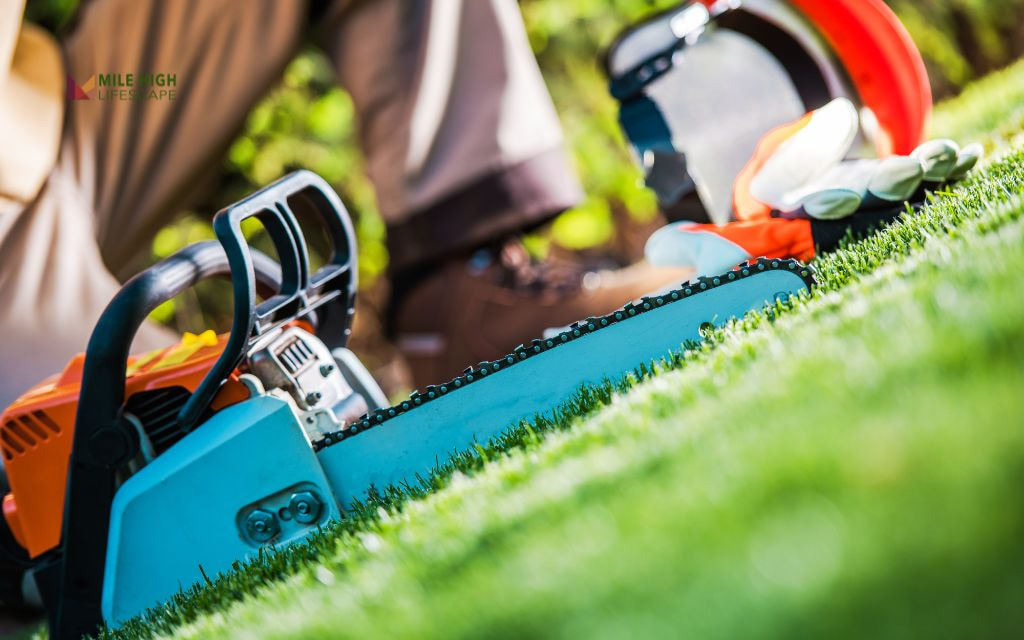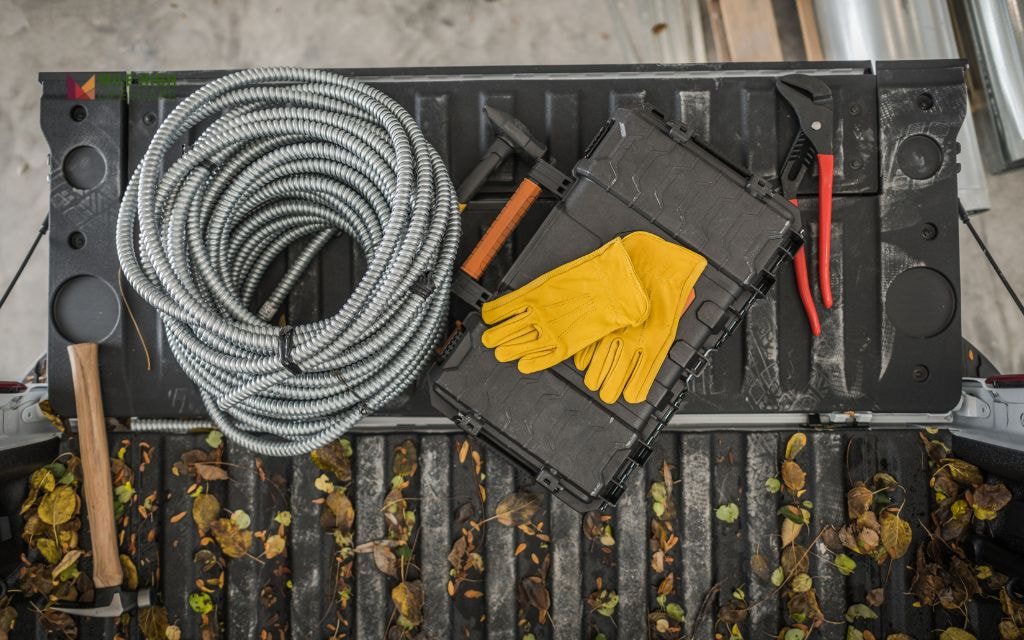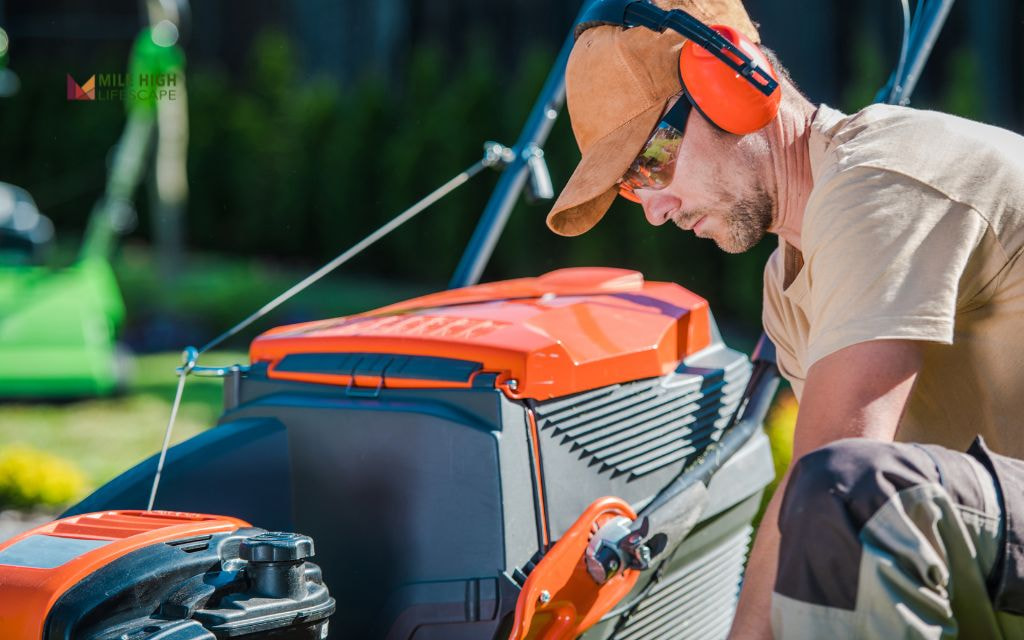Spring arrives, and you head to your garage, ready to tackle the season’s first lawn mowing. You turn the key on your riding mower, and… nothing happens. The battery is dead. Now what?
Can you jump a lawn mower with a car battery? Yes, you can – but only under specific conditions and with proper precautions. This common solution comes with significant risks that could leave you with bigger problems than just an uncut lawn.
At Mile High Lifescape, we’ve encountered this situation countless times across Denver and surrounding areas. We understand the frustration of equipment failures when you need them most. In this blog, we’ll help you answer this critical question.
What is Battery Compatibility?
Before attempting to jump-start your lawn mower with a car battery, you must understand the fundamental differences between these two power sources.
Voltage Requirements
Most modern riding lawn mowers operate on 12-volt batteries, matching standard car batteries. However, some older or smaller mowers use 6-volt systems. Using a 12-volt car battery on a 6-volt mower system will damage the electrical components beyond repair.
Check your mower’s battery specifications before proceeding. This information appears on the battery itself or in your owner’s manual.
Power Differences That Matter
Car batteries deliver significantly more power than lawn mower batteries. This difference creates potential risks:
| Feature | Car Battery | Lawn Mower Battery |
| Voltage | 12V | 12V (or 6V in older models) |
| Cold Cranking Amps (CCA) | 600-800 | 150-300 |
| Size | Larger | Smaller |
| Purpose | Power large engines & electrical systems | Power small engines with minimal systems |
The high amperage from car batteries can overwhelm a lawn mower’s electrical system. Think of it as using a fire hose to fill a drinking glass – the excessive force can cause damage.
Safe Jump-Starting 5-Step Procedure
If you determine your mower uses a 12-volt battery compatible with a car battery jump, follow these steps precisely to minimize risks.
Step 1: Before You Begin: Safety First
- Wear protective gloves and eye protection to shield yourself from electrical sparks, battery acid, and unexpected electrical discharge.
- Ensure both vehicles remain completely off during cable connection. This prevents power surges that could damage either electrical system.
- Inspect both batteries carefully for cracks, leaks, or corrosion. Battery acid is highly caustic and can cause chemical burns. A damaged battery also poses greater explosion risks.
- Remove all metal jewelry including watches, rings, bracelets, and necklaces. Metal conducts electricity and creates a shock hazard if it contacts battery terminals.
- Work in a well-ventilated area away from open flames or sparks. Batteries release hydrogen gas, which is invisible but highly flammable.
Step 2: Positioning the Vehicles
- Park the car close enough to the lawn mower so the jumper cables can reach both batteries comfortably.
- Leave enough space to work safely between the vehicles, but keep them close enough that the cables won’t be stretched tight.
- Engage parking brakes on both vehicles if applicable to prevent unexpected movement.
- Turn off all accessories in both vehicles (lights, radio, etc.) to prevent electrical draws during the jump process.

Step 3: Proper Cable Connection Sequence
- Identify the positive (+) and negative (-) terminals on both batteries. Positive terminals are typically marked with a plus sign or red color coding, while negative terminals show a minus sign or black color.
- Connect the red (positive) cable to the positive (+) terminal on the car battery first. The clamp should attach firmly to the terminal post, not to the cable or bracket.
- Connect the other end of the red cable to the positive (+) terminal on the mower battery, again ensuring a solid connection.
- Connect the black (negative) cable to the negative (-) terminal on the car battery, with the clamp firmly attached.
- Connect the other end of the black cable to a metal part of the mower frame away from the battery, fuel lines, and moving parts. This “frame ground” connection reduces spark risk near the battery where hydrogen gas may be present.
Step 4: Starting and Disconnection Process
- Double-check all connections to ensure they’re secure before proceeding.
- Start the mower and allow it to run for 5-10 minutes. This gives the mower’s charging system time to begin replenishing the battery.
- If the mower doesn’t start immediately, wait 2-3 minutes and try again. Multiple failed attempts could indicate a problem beyond battery power.
- Once the mower is running, disconnect the cables in the exact reverse order of connection:
- First, remove the black (negative) cable from the mower frame
- Second, remove the black cable from the car battery’s negative terminal
- Third, remove the red (positive) cable from the mower battery
- Finally, remove the red cable from the car battery
- This specific disconnection sequence minimizes the risk of sparks near either battery and prevents electrical system damage.
Step 5: After the Jump
- Allow the mower to run continuously for at least 30 minutes after the jump to recharge the battery.
- Avoid immediately turning the mower off, as the battery may not have stored enough charge to restart.
- If the mower stalls shortly after disconnecting the jumper cables, the battery may be unable to hold a charge and requires replacement.
- Monitor the mower during the first few minutes of operation for any unusual sounds, smells, or behavior that might indicate electrical system damage.
Potential Risks and Prevention
Understanding what can go wrong helps prevent costly mistakes. When jump-starting your lawn mower with a car battery, several specific risks require your attention and careful management.
Electrical System Damage
How Damage Occurs
The lawn mower’s electrical components handle specific voltage and amperage ranges. Excessive power from a car battery can overwhelm these systems in several ways:
- Voltage Regulator Failure: Most mowers contain a voltage regulator that maintains consistent electrical flow. The higher output from a car battery (especially a running car) can burn out this component.
- Wiring Harness Overload: The thinner wires in a mower’s electrical system aren’t designed to handle the amperage from a car battery, potentially causing wires to heat up and melt their insulation.
- Circuit Board Damage: Modern mowers with electronic controls contain sensitive circuit boards that can fail when exposed to power surges.
- Alternator Burnout: The alternator in your mower charges the battery during operation. Excessive incoming current can damage its internal components.
Prevention Strategies
To protect your mower’s electrical system while jump-starting:
- Never Run the Car Engine: Keep the car turned off completely during the jump process. A running car’s alternator produces higher voltage than a mower can handle.
- Limit Connection Time: Maintain the connection only long enough to start the mower—typically less than one minute.
- Use Proper Cable Gauge: Ensure your jumper cables are appropriate for the task. Extremely heavy-duty cables designed for large vehicles can transfer too much power too quickly.
- Monitor for Heat: If any component of the mower becomes hot during the jump process, disconnect immediately.
Battery Explosion Hazards
Why Batteries Explode
Batteries produce hydrogen gas, which can ignite with a simple spark. This risk increases with older or damaged batteries for several reasons:
- Hydrogen Gas Accumulation: All lead-acid batteries produce hydrogen gas during charging and discharging. This invisible, odorless gas is highly flammable and explosive.
- Spark Creation: Connecting or disconnecting jumper cables incorrectly can create sparks near the battery, potentially igniting hydrogen gas.
- Battery Acid Splash: Physical damage or overheating can cause battery acid to leak or splash, causing chemical burns and property damage.
- Internal Short Circuits: Damaged batteries may have internal short circuits that create excessive heat during jumping.
Safety Measures
To minimize explosion and injury risks:
- Connect Negative to Frame: Always connect the negative cable to the mower frame rather than directly to the battery terminal. This “ground” connection provides a safer path for current while minimizing sparks near the battery.
- Ventilation is Critical: Always perform jump-starts in well-ventilated areas, never in enclosed spaces where hydrogen gas could accumulate.
- Proper Connection Sequence: Follow the connection and disconnection sequence precisely to minimize spark generation near either battery.
- Keep Fire Sources Away: Eliminate all potential ignition sources—including cigarettes, lighters, matches, and tools that might create sparks—from the jumping area.
- Protect Your Eyes: Battery explosions often occur without warning. Safety glasses protect your vision from acid splashes and debris.

Battery Terminal Corrosion Issues
The Corrosion Problem
Battery terminals frequently develop whitish-green corrosion that interferes with electrical connections:
- Poor Conductivity: Corrosion creates resistance at connection points, reducing power transfer efficiency during jumping.
- False Readings: Corroded terminals may lead you to believe a battery is dead when it’s actually just poorly connected.
- Accelerated Battery Drain: Even after a successful jump, corrosion continues to drain battery power faster than normal.
Managing Corrosion
To prevent and address corrosion issues:
- Clean Before Jumping: Remove corrosion from terminals using a wire brush and a solution of baking soda and water before attempting to jump-start.
- Ensure Solid Connections: Jumper cable clamps must contact clean metal, not corrosion. Wiggle the connections to ensure they’re solid.
- Apply Terminal Protectant: After jumping, apply battery terminal protectant spray or petroleum jelly to prevent future corrosion.
- Inspect Regularly: Make battery terminal inspection part of your regular mower maintenance routine.
3 Better Alternatives to Car Battery Jumps
While car batteries can work in emergencies, consider these safer options:
Portable Jump Starters
Dedicated lawn equipment jump starters provide the right power level for your mower without risking electrical system damage. These compact units cost $50-100 but save money by preventing potential damage.
Battery Chargers
A standard battery charger replenishes your mower battery safely over several hours. The slow charge helps restore battery health rather than just providing a quick start. For regular maintenance, a trickle charger keeps the battery topped up during off-season storage.
Battery Replacement
If your mower battery fails to hold a charge, replacement offers the most reliable solution. Most lawn mower batteries last 3-5 years with proper care. A fresh battery eliminates the need for jump-starts altogether.
Preventative Maintenance for Battery Longevity
Prevent future dead battery situations with these maintenance practices:
- Store the mower battery indoors during winter months or use a trickle charger
- Clean battery terminals regularly with a wire brush and baking soda solution
- Check voltage periodically with a multimeter (12.6V indicates a full charge)
- Start the mower monthly during off-seasons to maintain battery health
- Keep battery connections tight and free of corrosion
Need help with your lawn care or lawn mower in Denver? Contact Mile High Lifescape at (303) 877-9091 for expert service that keeps your lawn looking its best without equipment worries.

Frequently Asked Questions (FAQs)
Can you use a car battery to start a lawn mower battery?
Yes, but only for 12-volt mower batteries. Connect properly (negative to frame, not terminal), keep the car turned off, and disconnect promptly after starting.
Can you jump-start a lawn mower with a battery charger?
Yes. Use a charger with “boost” function or charge the battery for 10-15 minutes before starting. Follow charger instructions.
Can I jump a 12 volt battery with a car battery?
Yes. Ensure correct connections (positive to positive, negative to frame) and keep the car engine off to prevent electrical damage.
Can I jump-start a 6-volt mower battery with a car battery?
No. The voltage difference will immediately damage your mower’s electrical system.
How long should I run my mower after a jump-start?
At least 30 minutes to allow the charging system to replenish the battery.
Can I jump-start a mower in rainy conditions?
Never attempt any electrical work in wet conditions – this creates severe shock and short circuit hazards.
Conclusion
Can you jump a lawn mower with a car battery? Yes, but only with proper precautions and if the mower uses a 12-volt system. The risks often outweigh the convenience, especially when safer alternatives exist.
At Mile High Lifescape, we recommend investing in proper battery maintenance to avoid emergency situations altogether. For Denver homeowners facing persistent lawn equipment issues, our professional lawn care services eliminate the hassle of equipment maintenance entirely.
